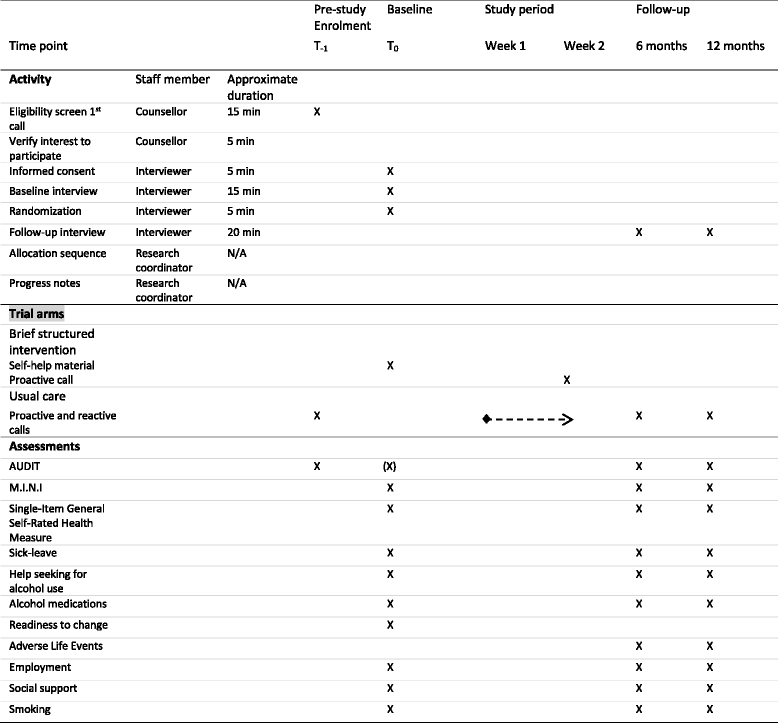Comparing counselling models for the hazardous use of alcohol at the Swedish National Alcohol Helpline: study protocol for a randomised controlled trial
- PMID: 28587621
- PMCID: PMC5461736
- DOI: 10.1186/s13063-017-2005-5
Comparing counselling models for the hazardous use of alcohol at the Swedish National Alcohol Helpline: study protocol for a randomised controlled trial
Abstract
Background: Hazardous and harmful consumption of alcohol is a leading cause of preventable disease and premature deaths. Modifying the amount and pattern of risky alcohol consumption conveys substantial benefits to individuals and to society at large. Telephone helplines provide a feasible alternative to face-to-face counselling in order to increase the reach of brief interventions aiming at modifying the hazardous and harmful use of alcohol. However, there is a lack of studies on the implementation and evaluation of population-based telephone services for the prevention and treatment of alcohol misuse.
Methods/design: A randomised controlled trial was designed to compare a brief, structured intervention to usual care within the Swedish National Alcohol Helpline (SAH), concerning their effectiveness on decreasing the hazardous use of alcohol. Between May 2015 and December 2017, about 300 callers are to be individually randomised with a 1:1 ratio to a brief, structured intervention (n = 150) or to usual care (n = 150). The brief, structured intervention consists of the delivery of a self-help booklet followed by one proactive call from SAH counsellors to monitor and give feedback about the client's progression. Callers assigned to usual care receive telephone counselling according to existing practice, i.e., motivational interviewing in a tailored and client-driven combination of proactive and reactive calls. The primary outcome is defined as a change from a higher to a lower AUDIT risk-level category between baseline and follow-up. General linear modeling will be used to calculate risk ratios of the outcome events. The primary analysis will follow an intention-to-treat (ITT) approach.
Discussion: The trial is designed to evaluate the effectiveness in decreasing the hazardous and harmful consumption of alcohol of a brief, structured intervention compared to usual care when delivered at the SAH. The results of the study will be used locally to improve the effectiveness of the service provided at the SAH. Additionally, they will expand the evidence base about optimal counselling models in population-based telephone services for alcohol misuse prevention and treatment.
Trial registration: ISRCNT.com, ID: ISRCTN13160878 . Retrospectively registered on 18 January 2016.
Keywords: Brief intervention; Counselling; Hazardous drinking; Randomised controlled trial; Telephone helpline.
Figures


Similar articles
-
A pragmatic randomised trial of two counselling models at the Swedish national alcohol helpline.BMC Psychiatry. 2019 Jul 8;19(1):213. doi: 10.1186/s12888-019-2199-z. BMC Psychiatry. 2019. PMID: 31286906 Free PMC article. Clinical Trial.
-
Randomised controlled study of two counselling models at the Swedish alcohol helpline: Effectiveness and sustainability outcomes at 12-month follow-up.Nordisk Alkohol Nark. 2022 Apr;39(2):163-174. doi: 10.1177/14550725211007823. Epub 2021 Apr 27. Nordisk Alkohol Nark. 2022. PMID: 35757087 Free PMC article.
-
Effectiveness of screening and brief alcohol intervention in primary care (SIPS trial): pragmatic cluster randomised controlled trial.BMJ. 2013 Jan 9;346:e8501. doi: 10.1136/bmj.e8501. BMJ. 2013. PMID: 23303891 Free PMC article. Clinical Trial.
-
The Cochrane 2018 Review on Brief Interventions in Primary Care for Hazardous and Harmful Alcohol Consumption: A Distillation for Clinicians and Policy Makers.Alcohol Alcohol. 2019 Jul 1;54(4):417-427. doi: 10.1093/alcalc/agz035. Alcohol Alcohol. 2019. PMID: 31062859
-
NICE work if you can get it: Development of national guidance incorporating screening and brief intervention to prevent hazardous and harmful drinking in England.Drug Alcohol Rev. 2010 Nov;29(6):589-95. doi: 10.1111/j.1465-3362.2010.00236.x. Drug Alcohol Rev. 2010. PMID: 20973841 Review.
Cited by
-
Interpretation of within-group change in randomised trials.BMC Psychiatry. 2020 May 14;20(1):239. doi: 10.1186/s12888-020-02641-w. BMC Psychiatry. 2020. PMID: 32410596 Free PMC article.
-
A pragmatic randomised trial of two counselling models at the Swedish national alcohol helpline.BMC Psychiatry. 2019 Jul 8;19(1):213. doi: 10.1186/s12888-019-2199-z. BMC Psychiatry. 2019. PMID: 31286906 Free PMC article. Clinical Trial.
-
Randomised controlled study of two counselling models at the Swedish alcohol helpline: Effectiveness and sustainability outcomes at 12-month follow-up.Nordisk Alkohol Nark. 2022 Apr;39(2):163-174. doi: 10.1177/14550725211007823. Epub 2021 Apr 27. Nordisk Alkohol Nark. 2022. PMID: 35757087 Free PMC article.
References
-
- Forouzanfar MH, Afshin A, Alexander LT, Anderson HR, Bhutta ZA, Biryukov S, et al. Global, regional, and national comparative risk assessment of 79 behavioural, environmental and occupational, and metabolic risks or clusters of risks, 1990–2015: a systematic analysis for the Global Burden of Disease Study 2015. Lancet. 2016;388:1659–724. - PMC - PubMed
-
- Alkoholvanor—nationella resultat och tidsserier 2015 [Alcohol use—national results and time series 2015]. Folkhälsomyndigheten [Public Health Agency of Sweden]. 2016. https://www.folkhalsomyndigheten.se/folkhalsorapportering-statistik/stat.... Accessed 15 Aug 2016.
-
- Blomqvist J, Cunningham J, Wallander L, Collin L. Att förbättra sina dryckesvanor: om olika mönster för förändring och om vad vården betyder [Improving one’s drinking habits—on different patterns of change and on the role of alcohol treatment]. Centre for Social Research on Alcohol and Drugs, SoRAD. 2007. http://www.diva-portal.org/smash/record.jsf?pid=diva2:199785. Accessed 15 Aug 2016.
Publication types
MeSH terms
Associated data
LinkOut - more resources
Full Text Sources
Other Literature Sources
Medical
Miscellaneous

